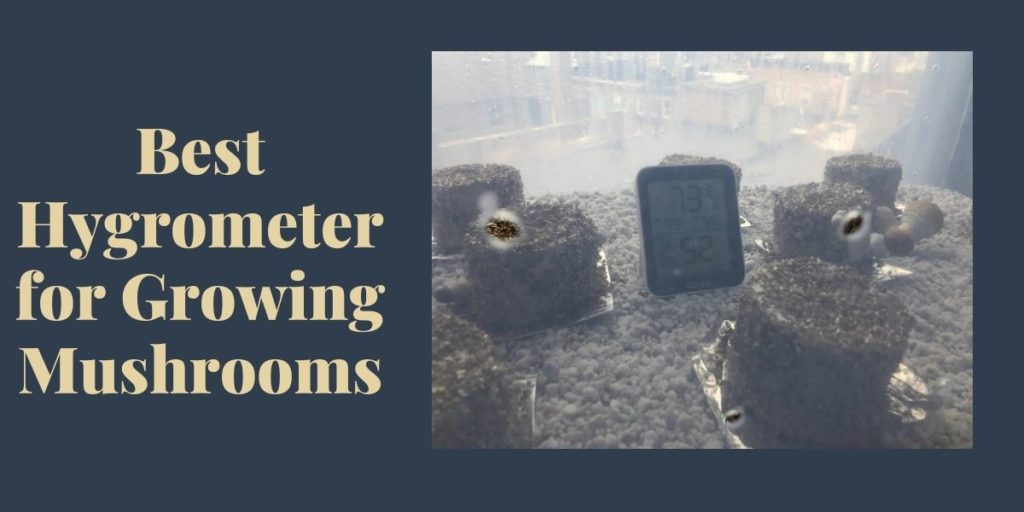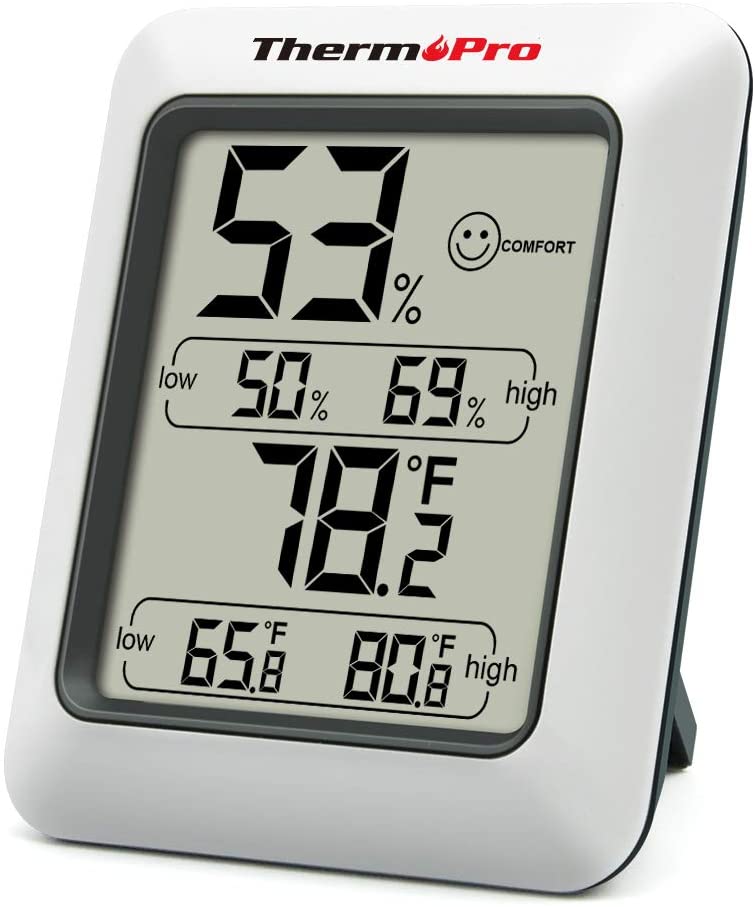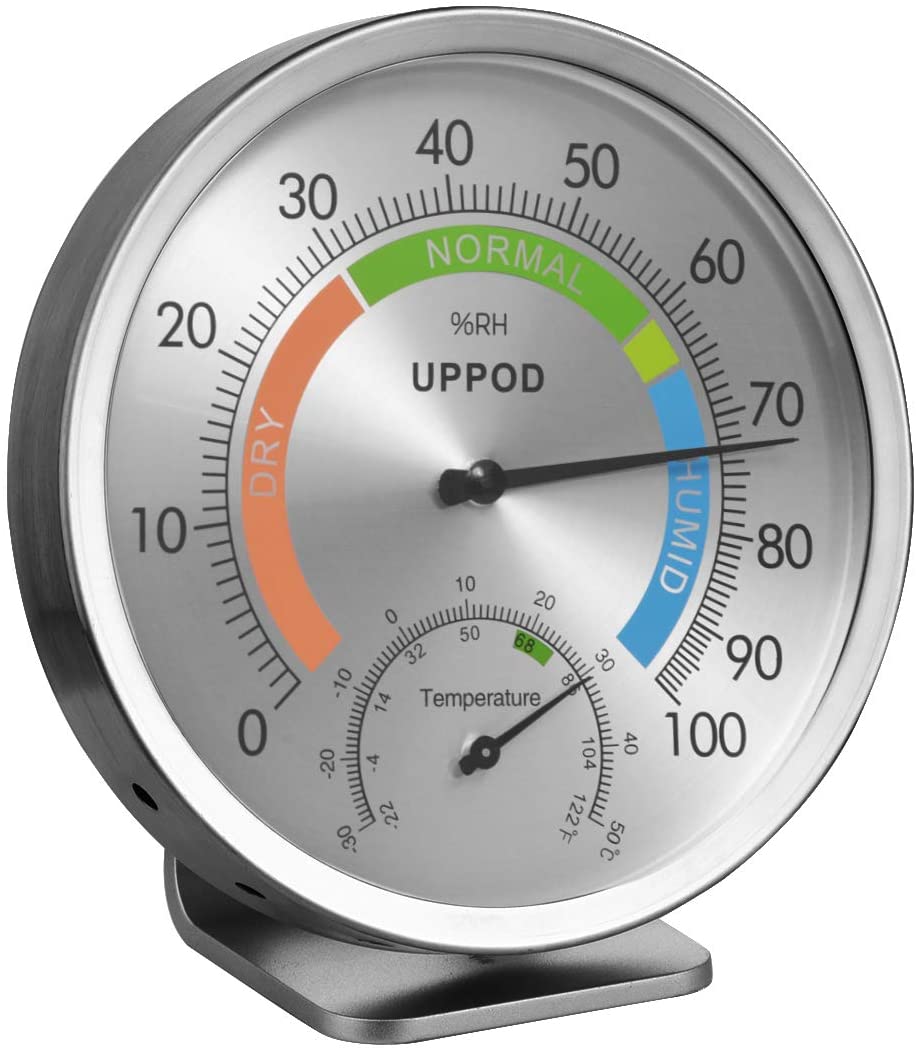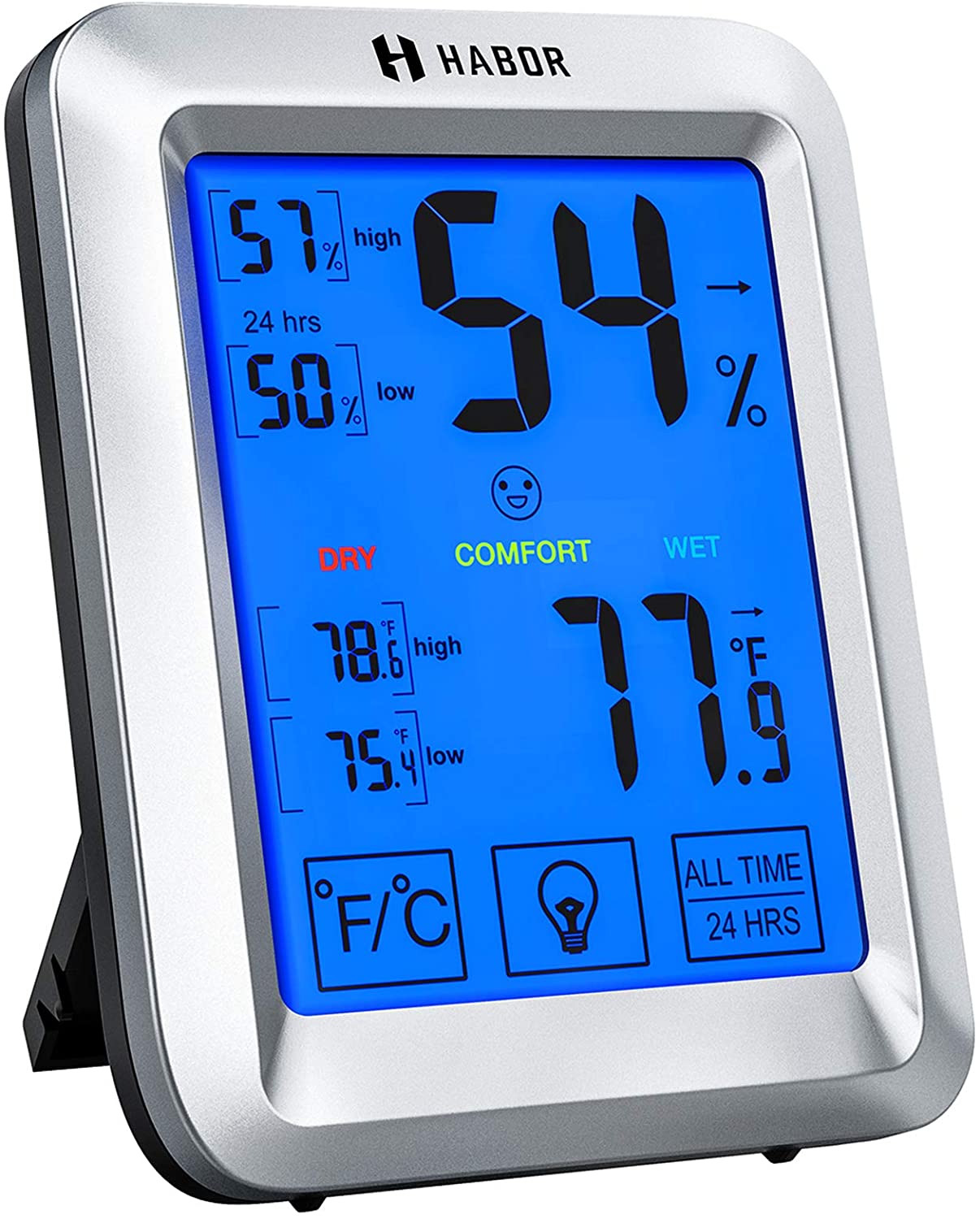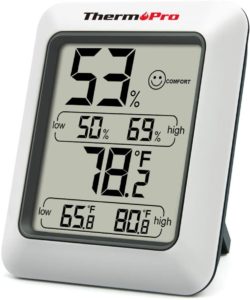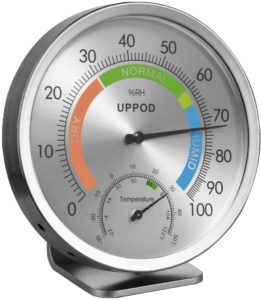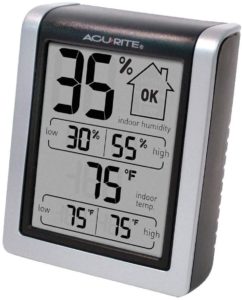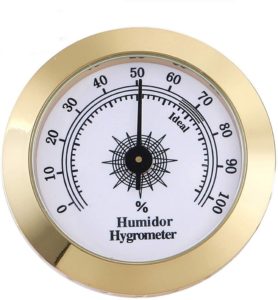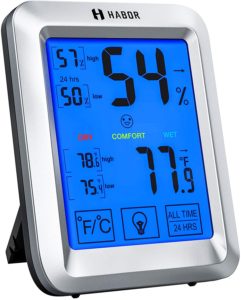Generally speaking, a hygrometer is a device for measuring humidity. Knowing the outdoor humidity is important for meteorologists, while knowing the indoor humidity is important to anyone wishing to control humidity for any reason—museum curators who need to keep their collections very dry, for example. Even ordinary homeowners sometimes use hygrometers to discover and address damp corners before mold and other problems can develop.
Whether you’re growing magic mushrooms or culinary mushrooms, most fruit best in high humidity, usually 85% or better. Many indoor growers use hygrometers to make sure their grow chambers are in the optimum range and to monitor their humidifiers.
It’s fair to point out that not all growers use hygrometers[i]. It’s difficult to find a unit at a reasonable price that reads accurately at very high humidity, so many growers find it easier to just estimate based on factors such as the presence of condensation on the chamber walls. Condensation is the result of the relationship between the humidity in the chamber and the temperature difference between the chamber and the room it’s sitting in—place the chamber in a warm enough room, and no condensation will form no matter how humid the air inside the chamber is. And yet an experienced grower will know what temperature differences should produce condensation, and will know to mist if it’s not there.
But inexperienced growers, those with large or automated set-ups, or anyone who needs very precise measurements will appreciate a quality hygrometer.
IMAGE | PRODUCT | Header | ||
|---|---|---|---|---|
OUR #1 RATED High accuracy of ±2~3%RH and ±1°F | ||||
Accurate to within +\- 5% | ||||
Rapid Sensing & High Accuracy updates record every 10 seconds | ||||
Types of Hygrometers
Strictly speaking, “hygrometer” is a whole family of devices that differ not only in how they measure but also in what they measure. That is, unlike a thermometer, which always measures the same variable (temperature) no matter what sort of technology it uses, hygrometers can measure any of a group of related variables[ii][iii], all of which bear, directly or indirectly, on the amount of water in the air.
The buyer doesn’t really need to know which is which—it’s perfectly fine to just look for a gadget that will spit out the necessary numbers, and never mind the how or the why. In fact, consumers may not be able to find out which a given model belongs to, since product descriptions don’t necessarily include the information. And yet knowing the different types of technologies and the advantages and disadvantages of each provides useful context for making sense of product descriptions.
The following discussion its not exhaustive—it’s just intended as an introduction to the topic.
Hair-tension Hygrometer
The hair-tension hygrometer is the oldest type of humidity sensor. The first one did indeed involve a human hair, although many now use cellulose or nylon instead. The important thing is that there is a fiber of some sort that expands and contracts due to humidity, thereby moving a needle or a dial. These devices are inexpensive and durable.
Metal-paper Coil Hygrometers
Metal-paper coil hygrometers also depend on an object changing shape in response to humidity, and they are also inexpensive. They aren’t very accurate, and so are used in circumstances where getting within about 10% is good enough.
Dew-point/Frost-point Hygrometers
The dew point is the temperature at which dew will form. Because warm air holds more moisture, the more humid the air is, the higher the dew-point is. Dew-point or condensation hygrometers work by chilling a mirror until condensation forms on it, then recording that temperature. Devices designed to work below freezing are called frost-point hygrometers (and are clearly irrelevant for mushroom growing). Dew-point hygrometers are super-accurate (far more so than a grower needs) and do not need to be calibrated. They are used in scientific research.
Electrical Hydrometers
No, an electrical hygrometer is not simply one with a digital read-out; they are based on how humidity changes the behavior of electricity. Generally, the sensor sits inside a semiconductor that can absorb water and records changes in either capacitance or resistance, though there are other types as well. Both the capacitance and resistance versions are vulnerable to contamination. Resistance types fail if too much condensation forms inside the unit.
Psychrometers
A psychrometer has two thermometers, one with a wet bulb, the other dry. The drier the air, the faster the moisture evaporates off the wet bulb, cooling that thermometer more. The difference between the readings of the two thermometers is then used to calculate the humidity. Air has to move past the wet bulb, and can be sucked into the device for that purpose, as in aspirating psychrometers, or the bulb itself can whirl around, as in sling psychrometers. Not surprisingly, the former is the smaller, more portable option. Psychrometers in general have a few limitations; they don’t work below freezing, and they don’t work if the humidity is below 20%. Neither is a problem for mushroom growers. They’re also less accurate in very small spaces because they themselves emit moisture. They are usually used either outdoors or in large indoor spaces.
What to Consider when Choosing a Hygrometer?
Once a grower has decided to use a hygrometer (and as noted, many decide not to), the choice of model depends on the intersection of a couple of different issues.
The first issue is range. Hygrometers are at their most accurate within a fairly narrow range of humidity’s and temperatures, and where the range lies depends on the model. A museum curator, for example, would need a hygrometer that was very sensitive at extremely low humidity, because the goal would be to keep the humidity of the museum below a low threshold for the safety of the collection. A hygrometer a museum curator would like would likely not be anywhere near accurate above 80% humidity, and would therefore be useless to a mushroom grower. Look for a model that is at its most accurate in the temperature and humidity range that the grow chamber should be.
Next up is durability, especially with respect to condensation. Some hygrometers fail if condensation forms inside them, as it is almost sure to do if kept in a grow chamber above 85% humidity for any length of time. There are ways around the problem, ranging from just removing the device when a reading isn’t needed all the way to major electrical engineering projects, but the simplest solution is to get a model that doesn’t mind being damp. Above all, it’s important to know whether dampness is a problem requiring a solution or not.
Cost is, arguably, next on the list. If a hygrometer won’t read in the right range or breaks promptly because of condensation, then its price is irrelevant. But once those two basics are covered, it’s time to decide on a budget. There are hygrometers that cost thousands of dollars, but they are typically used for meteorological research, where extreme precision is important. Mushroom growers are more likely to gravitate to the other end of the scale, where home models are available for less than $10. A few more dollars buys more precision and reliability (the lowest-cost models seem to have a high unexplained failure rate), but many users are quite satisfied with very simple, low-cost devices.
Accuracy is important, though how important it is varies from grower to grower. Some folks might need very precise information, while others only want a general idea. The accuracy of a given brand should be listed as part of its product information. It’s also not uncommon for hygrometers to get less accurate over time—most need regular re-calibration, so it’s important that the screw or other control used for re-calibration works well and makes sense. Having a second hygrometer on hand, so each can be used to check the other’s accuracy, helps too.
Finally there are bells and whistles, features that may have a lot to do with the usefulness of the device but aren’t directly involved with sensing humidity. For example, does the display have its own light? And if it doesn’t, can the display still be read under whatever lighting conditions exist in the grow chamber? These extra features often reflect the unit’s intended use. For example, many include a dry/comfortable/wet indicator that has nothing to do with mushroom growing. Unfortunately, few if any are designed for mushroom cultivation, so it’s important to make sure that a given model’s bells and whistles won’t get in the way of its use in a grow chamber.
Whether the display is digital or analogue is not that important, except that it suggests wither the sensor is mechanical or electric, which in turn bears on the unit’s accuracy and reliability. Digital models tend to be the cheaper sort, in both senses of the word, but again many digital models do just fine.
The Top 5 Hygrometers for Growing Mushrooms
The following list includes a number of popular models. They are “top,” but they are not necessarily the best for everybody, because grower’s needs vary. Most of them fall into the “inexpensive digital hygrometer” category.
1. ThermoPro TP50 Digital Hygrometer
The ThermoPro is a small, digital hygrometer and thermometer unit designed primarily for home use, but it also does well in a variety of other contexts, including greenhouses and terrariums. When the humidity is between 30% and 80%, the hygrometer is accurate plus or minus just 2% humidity—a range of greatest accuracy that is low for a mushroom grower’s needs, but even outside of that range it is accurate plus or minus 3%. It can respond to new conditions within 10 seconds, and records recent high and low readings of both temperature and humidity. The price is low, though somewhat higher than for some digital hygrometers.
Quality varies. Although most users report excellent results, some units arrive not working well. Others cease working well after only a few months. And unfortunately this model cannot be re-calibrated, so once a unit goes bad, it is simply done.
Buy the ThermoPro TP50 Digital Hygrometer Here
2. LittleGood 5″ Indoor Outdoor Hygrometer/Thermometer
A medium-sized analogue hygrometer and thermometer. Not only is the display analogue, but the sensor is mechanical not electric, meaning that the unit requires no batteries. It is accurate to plus or minus 5% anywhere within 1% to 99% humidity—meaning it is less accurate than some other models, but still good enough for most users. Units usually arrive reading a bit off, but since they have re-calibration screws, users can easily adjust the device as needed. The price is a little higher than some, but still very affordable. Can either sit on a shelf or hang on a wall, an advantage for growers whose grow chamber floors might be occupied by mushrooms. Users get good results. Naysayers seem to be mostly those who don’t understand re-calibration.
Buy the LittleGood Hygrometer Here
3. AcuRite 00613 Digital Hygrometer & Indoor Thermometer
Another small, digital hygrometer and thermometer. Like most, it is designed primarily for use in the home, for the benefit of human comfort. Its accuracy is not listed, but its range goes as high as 96% humidity. It is pre-calibrated, meaning it cannot be re-calibrated, but most users find that it is accurate and reliable. Some units do arrive with issues.
The AcuRite can sit on a table or hang on a wall, a good option for growers. The small size is convenient, and the price is very good.
Buy the AcuRite 00613 Digital Hygrometer Here
4. Cigar Hygrometer, Anync Round Hygrometer for Cigar Humidor
As the name implies, this analogue hygrometer is designed for use in humidors, but has features growers will appreciate. It’s small and sleek, about the size and shape of a large Reeces Peanut Butter Cup, with an attractive aluminum housing. A removable rubber ring acts as a seal if the user wants to insert the device in a hole in the humidor lid—or in the cover of a grow chamber. Alternatively, the whole unit can be placed inside. The price is lower than almost anything else available, and yet the accuracy is much better—within 0.5%. The hygrometer can be re-calibrated as needed.
There is no thermometer display. For users who don’t need a thermometer, its absence leaves the design sleeker and more elegant-looking. Its range is not listed—and for a device designed for humidors, which should maintain a humidity much lower than that of a grow chamber, that is a concern. Some users report units arriving in a non-functional state, but most find this model extremely accurate and reliable.
Buy the Anync Cigar Hygrometer Here
5. Habor Hygrometer Indoor Thermometer, Humidity Gauge Room Thermometer
Habor’s little digital hygrometer and thermometer has a stripped-down, no-frills design that fits anywhere (it can be wall-mounted) and is easy to read. Between 20% and 95% humidity it is accurate plus or minus 5%, and it responds to new conditions within ten seconds. The price is excellent. Quality varies somewhat, but relatively few naysayers report poor quality—instead, most complaints seem to be from people who simply wanted something else, usually something larger. This one is tiny, an advantage for small grow chambers.
References:
[i] Rebelutions (2012). What’s a Good Hygrometer You Use?
[ii] Biles, J. (2017). Instruments that are used to Predict Weather. Sciencing website, accessed November 18, 2020.
[iii] (n.d.). Types of Hygrometers for Multiple Uses.

